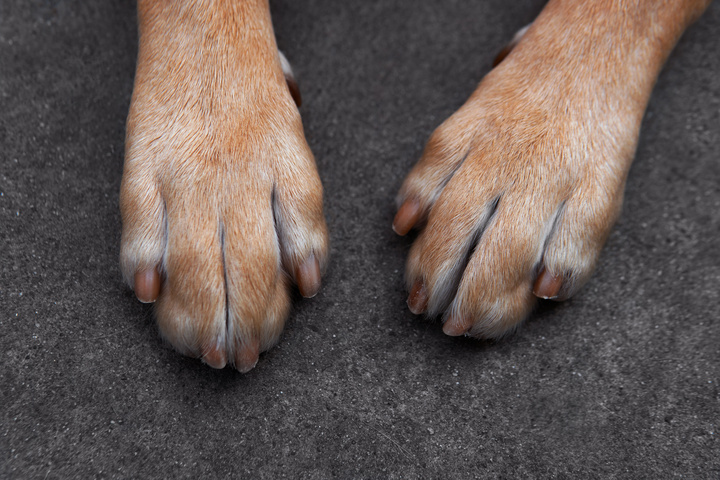You feed your dog the highest-quality diet, groom them every day, and ensure they get plenty of exercise, attention, and training. You know about dog behavior and all the signs of illness or distress to watch out for.
However, you might overlook one crucial thing—your dog’s paw health. Your dog’s paws can tell you more than you realize about their well-being, giving you clues that you might not notice otherwise.
In this article, we’ll explore how paying attention to your pet’s paws can provide valuable insights into their health status, helping you provide the best possible care for your beloved companion.
Follow the pawprints: What your dog’s paws say about their health
Moisture and texture
Excessively dry or cracked paw pads may indicate dehydration, lack of proper grooming, or exposure to harsh environmental conditions. Many dogs get dry or cracked paw pads from walking on pavement that is either extremely hot or extremely cold. Winter ice-melt chemicals and salt can also damage your pup’s paw pads.
It’s important to address changes in moisture or texture as soon as possible, as dry and cracked paw pads can contribute to irritation, infection, or other more significant health concerns.
How to fix: Once you’ve ensured your dog is properly hydrated, try to eliminate any external factors that could be causing their feet to dry out. The ASPCA recommends using a paw protectant like petroleum jelly or putting booties on your dog’s paws before taking them on winter walks. After your dog spends any time outside, wipe their feet with a wet washcloth to remove any debris or chemicals.
Apply dog-safe paw moisturizers, such as coconut oil, to help rehydrate their paw pads and prevent them from cracking. If you decide to use a topical treatment on their paws, be sure to rub it in well. Otherwise, they’ll just lick it off!
Note: Never take your dog on a walk if the pavement is too hot to touch with your hand. If it’s too hot for you, it’s certainly too hot for them!
Foreign objects
Dogs walk, run, and play barefoot all day long. It’s only natural that they should pick up a few irritating sticks and stones throughout their adventures. These objects can cause various issues if not removed, including limping, pain, lameness, infection, and excessive chewing.
How to fix: Get into the habit of inspecting your dog’s paws each evening for any thorns, sharp rocks, burrs, splinters, or other foreign objects. Pay special attention to between the toes and use your fingers to feel any raised lumps or bumps.
Checking your dog’s feet is also an excellent opportunity to assess their paw health and monitor any possible infections or other issues.
Changing in color
Normal paw pads are usually black or pink, depending on your dog’s breed and coloring. Changes in color, such as redness or darkening, may indicate inflammation, infection, or circulatory issues.
Overlicking can also cause salivary staining, which results from a substance in the dog’s saliva called porphyrin.
How to fix: Addressing the underlying issue is the best way to determine if the color change is cause for concern. Most overlicking is caused by boredom, pododermatitis (canine foot inflammation) from food or contact allergies, parasite infections, or yeast infections.
If your dog’s paws begin to change color, take them to the vet to rule out any serious health concerns.
Odor
Unless your dog stepped in a pile of poop (or another unsavory substance), their feet shouldn’t stink. Dogs are incredibly adept at cleaning their feet and removing any stinky gunk they might encounter. Therefore, an “off” or rotten smell could indicate an underlying problem like an infection, yeast overgrowth, or bacteria buildup.
How to fix it: Use a wet washcloth to clean their paws and remove any debris or dirt contributing to the odor. Make sure to dry their feet after washing them, as wet feet are a welcome environment for fungal growth.
Inspect their feet for other signs of infection, such as redness, swelling, discharge, or sores. If you notice any of these symptoms, a behavior change, or the odor lingers, make an appointment with the vet.
Nail problems
Grooming is more than brushing your dog’s fur. Looking after your dog’s nails is an essential step in grooming that many dog owners neglect. Unfortunately, overgrown, cracked, or damaged nails can lead to infection if left untreated.
How to fix it: In this case, prevention is the best medicine. Experts recommend trimming your dog’s nails every 3-4 weeks if they aren’t regularly walking on concrete or other rough surfaces. Use caution when trimming your pup’s nails, as it can be very painful if you cut them too short.
If you are worried about trimming your dog’s nails, a licensed groomer or veterinarian can help.
Don’t neglect the paws!
Your dog’s paws can tell you a lot about your canine companion — it’s time to start listening! By prioritizing your dog’s paw health, you’re not just taking care of their feet but getting a glimpse into their overall well-being.






